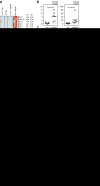TWEAK mediates inflammation in experimental atopic dermatitis and psoriasis
- PMID: 28530223
- PMCID: PMC5493595
- DOI: 10.1038/ncomms15395
TWEAK mediates inflammation in experimental atopic dermatitis and psoriasis
Abstract
Atopic dermatitis (AD) and psoriasis are driven by alternate type 2 and type 17 immune responses, but some proteins might be critical to both diseases. Here we show that a deficiency of the TNF superfamily molecule TWEAK (TNFSF12) in mice results in defective maintenance of AD-specific T helper type 2 (Th2) and psoriasis-specific Th17 cells in the skin, and impaired expression of disease-characteristic chemokines and cytokines, such as CCL17 and TSLP in AD, and CCL20 and IL-19 in psoriasis. The TWEAK receptor, Fn14, is upregulated in keratinocytes and dermal fibroblasts, and TWEAK induces these cytokines and chemokines alone and in synergy with the signature T helper cytokines of either disease, IL-13 and IL-17. Furthermore, subcutaneous injection of recombinant TWEAK into naive mice induces cutaneous inflammation with histological and molecular signs of both diseases. TWEAK is therefore a critical contributor to skin inflammation and a possible therapeutic target in AD and psoriasis.
Conflict of interest statement
The authors declare no competing financial interests.
Figures







Similar articles
-
Experimental atopic dermatitis is dependent on the TWEAK/Fn14 signaling pathway.Clin Exp Immunol. 2020 Jan;199(1):56-67. doi: 10.1111/cei.13373. Epub 2019 Sep 17. Clin Exp Immunol. 2020. PMID: 31515807 Free PMC article.
-
TWEAK functions with TNF and IL-17 on keratinocytes and is a potential target for psoriasis therapy.Sci Immunol. 2021 Nov 19;6(65):eabi8823. doi: 10.1126/sciimmunol.abi8823. Epub 2021 Nov 19. Sci Immunol. 2021. PMID: 34797693 Free PMC article.
-
Fn14 deficiency ameliorates psoriasis-like skin disease in a murine model.Cell Death Dis. 2018 Jul 23;9(8):801. doi: 10.1038/s41419-018-0820-6. Cell Death Dis. 2018. PMID: 30038329 Free PMC article.
-
TWEAK/Fn14 Activation Participates in Skin Inflammation.Mediators Inflamm. 2017;2017:6746870. doi: 10.1155/2017/6746870. Epub 2017 Sep 6. Mediators Inflamm. 2017. PMID: 29038621 Free PMC article. Review.
-
Out of the TWEAKlight: Elucidating the Role of Fn14 and TWEAK in Acute Kidney Injury.Semin Nephrol. 2016 May;36(3):189-98. doi: 10.1016/j.semnephrol.2016.03.006. Semin Nephrol. 2016. PMID: 27339384 Review.
Cited by
-
Single-cell landscape of bronchoalveolar immune cells in patients with immune checkpoint inhibitor-related pneumonitis.NPJ Precis Oncol. 2024 Oct 5;8(1):226. doi: 10.1038/s41698-024-00715-6. NPJ Precis Oncol. 2024. PMID: 39369126 Free PMC article.
-
Topical TWEAK Accelerates Healing of Experimental Burn Wounds in Mice.Front Pharmacol. 2018 Jun 21;9:660. doi: 10.3389/fphar.2018.00660. eCollection 2018. Front Pharmacol. 2018. PMID: 29977207 Free PMC article.
-
Circulating inflammatory proteins as pathogenic mediators and potential therapeutic targets in myasthenia gravis.Neurol Sci. 2025 Jun 26. doi: 10.1007/s10072-025-08328-y. Online ahead of print. Neurol Sci. 2025. PMID: 40569533
-
Role of fibroblasts in nonfibrotic autoimmune skin diseases.Mol Med. 2024 Oct 17;30(1):178. doi: 10.1186/s10020-024-00949-x. Mol Med. 2024. PMID: 39420283 Free PMC article. Review.
-
Synergistic effects of LCN2 and TWEAK on the progression of psoriasis.Cell Mol Immunol. 2025 Jul;22(7):760-775. doi: 10.1038/s41423-025-01292-9. Epub 2025 May 15. Cell Mol Immunol. 2025. PMID: 40369189 Free PMC article.
References
-
- Bieber T. Atopic dermatitis. N. Engl. J. Med. 358, 1483–1494 (2008). - PubMed
-
- Nestle F. O., Kaplan D. H. & Barker J. Psoriasis. N. Engl. J. Med. 361, 496–509 (2009). - PubMed
-
- Ring J., Mohrenschlager M. & Weidinger S. Molecular genetics of atopic eczema. Chem. Immunol. Allergy 96, 24–29 (2012). - PubMed
-
- Bieber T. & Novak N. Pathogenesis of atopic dermatitis: new developments. Curr. Allergy Asthma Rep. 9, 291–294 (2009). - PubMed
Publication types
MeSH terms
Substances
Grants and funding
LinkOut - more resources
Full Text Sources
Other Literature Sources
Medical
Molecular Biology Databases

